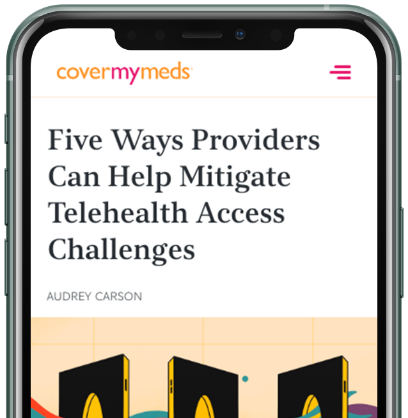Telehealth Prescribing is Low — Decision Support Can Help
Telehealth will continue to be a popular option for many patients — and it’s important that providers feel confident prescribing medication virtually.

While it’s indisputable that telehealth has benefitted both patients and their healthcare providers during the COVID-19 pandemic — it isn’t without challenges.
Consider a patient’s typical in-person office visit with their primary care physician. First, they’re welcomed at reception, and demographic and insurance information are verified. Next, the provider’s care team checks vital signs, reviews current allergy and medication information, as well as confirms their preferred pharmacy. In this setting, the provider does not see their patient until after data-gathering is complete.
With telehealth, providers may be asked to integrate several of these pre-visit workflows into their patient visit — without the ability to easily consult prior visit records or their support staff. There is a lot to consider in this “new normal.”
The complexity of a new provider-patient experience — along with several factors outlined below — has led to a significant drop in prescriptions written across the United States. Before the pandemic, about 20 million new prescriptions were filled every week. In April, this figure dropped to 11 million and has since rebounded slightly, to about 15 million — still 25 percent below pre-pandemic numbers.Five Surprising Facts About COVID-19 Prescription Trends for Retail and Mail Pharmacies, Drug Channels Institute, 2020
This drop in prescribing could mean a patient’s condition remains untreated because they are not seeking care, or that a patient on chronic maintenance medication is less adherent to their prescribed therapy.
While office visit numbers are rebounding from this spring, as of the week of October 30th, the only diagnosis groups at or above 2019 levels are pregnancy and childbirth, neoplasms, digestive system and genitourinary.Symphony Health Data, 2020 Telehealth will continue to be a popular option for many patientsMedical Claims Data Analysis, IQVIA, 2020 — and it’s important that providers feel confident prescribing medication virtually.
A shift in telehealth usage
Before the pandemic, telehealth was used primarily for mental health conditions.COVID-19 and lasting trends that are redefining U.S. healthcare, IQVIA, 2020 As usage increased rapidly in the spring and continued into summer, these appointments began to reflect a wider range of diagnoses.
Usage has leveled off, but telehealth appointments still comprised 10 percent of total visit claims at the end of July — up from one percent in early March.Medical Claims Data Analysis, IQVIA, 2020
The quick adoption of telehealth, in light of the pandemic, indicates virtual care will continue for a variety of healthcare needs.COVID-19 and lasting trends that are redefining U.S. healthcare, IQVIA, 2020 In the future, it’s likely we’ll adopt a hybrid model, with initial consultations and new diagnoses taking place in-person and follow-up visits conducted virtually.COVID-19 and lasting trends that are redefining U.S. healthcare, IQVIA, 2020
For those appointments still taking place virtually, providers can benefit from a decision support solution that equips them with complete prescribing information in one place.
Telehealth and prescribing: the challenge
Telehealth appointments — shorter, of lower acuity and more frequently requested by existing patients not in need of a new therapy — are less likely to result in a new prescription than an in-person visit. When a provider visits with a patient virtually, therapy initiation is down:Five Surprising Facts About COVID-19 Prescription Trends for Retail and Mail Pharmacies, Drug Channels Institute, 2020
- 18% for dermatologic visits
- 25% for pediatric visits
- 27% for primary care visits
- 39% for cardiology visits
- 40% for psychiatric visits
While some barriers to virtual prescribing are likely to remain into the future, access to prescription decision support tools — pulling critical information together at the point of prescribing — can help providers make the best medication decision for each patient, regardless of setting.
One workflow for patient information
As they’re likely to be the sole healthcare professional a patient interacts with during a telehealth visit, providers can benefit from access to an all-in-one prescription decision support solution.
Telehealth platforms are great tools for offering providers prescribing information — from prescription cost and formulary alternatives to cash price information. But with two sides to every telehealth visit, they’re also useful for bringing price transparency tools directly to the patient.
CoverMyMeds saw a unique opportunity to display accurate prescription decision support for providers on one side of the visit. These solutions can display consumer-based pricing options to enable the patient to make an informed therapy decision on the other side of the visit.
With one workflow to access prescription decision support solutions, providers can quickly find the information they need, so they can facilitate open, constructive conversations with their patients and prescribe with confidence, even if they’re on the phone, laptop or tablet. After the telehealth visit, the patient has the tools to shop with confidence for a fair price for their medication, increasing the likelihood they’ll remain adherent to therapy.
The latest healthcare insights, floated right to your inbox.





